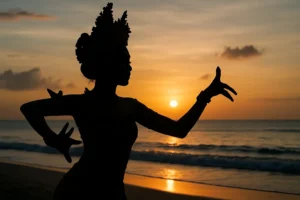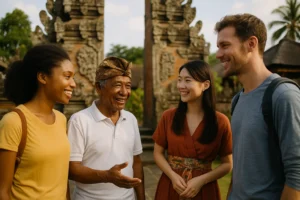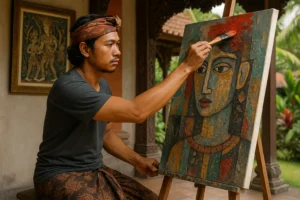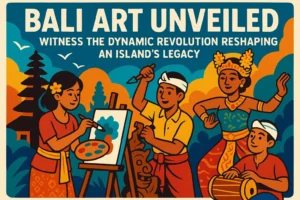Bali Art Unveiled: Witness the Dynamic Revolution Reshaping an Island’s Legacy

Discover the Bali Art Revolution! Explore how a new wave of Balinese artists are blending traditional craftsmanship with innovative contemporary styles.
Imagine an island where every brushstroke, every chisel mark, and every dance move tells a story centuries old, yet vibrates with a thrilling new energy. That’s Bali Art today. Beyond its timeless beauty and spiritual depth, Bali’s artistic landscape is undergoing a profound transformation – a revolution led by a bold new generation of artists. They’re not just preserving tradition; they’re reinventing it, blending ancient craftsmanship with innovative creativity. Dive into this vibrant new wave that’s transforming how art is perceived, created, and celebrated not only within Bali but internationally, and discover the remarkable dimensions of this artistic renaissance.
The Rise of Bali Art: A New Wave of Creativity
The foundation of Bali Art has long been rooted in age-old techniques passed down through generations—from intricate wood carvings and exquisite silverwork to traditional painting styles like Kamasan and performance arts such as dance and shadow puppetry. Yet, today goes beyond preservation. A dynamic new wave of artists are redefining tradition by integrating contemporary themes, experimental mediums, and global influences into their craft.
This transformation began as young Balinese creatives, inspired by their cultural roots and modern global art movements, started to explore bold visual narratives, blending the past and present with stunning originality. This has opened doors for Balinese art to be appreciated not only as cultural artifacts but also as contemporary expressions of identity, globalization, and ecological consciousness.
The breakthrough has been significant:
- Bali Art is gaining international gallery recognition and representation.
- New art districts and creative hubs have been established within Bali.
- Cross-disciplinary collaborations (art, technology, fashion) are flourishing.
Bali Art Revolution: Innovative Mediums and Styles
One of the most visible signs of revolution in Bali Art is the expanding diversity of mediums and artistic styles. Today’s artists are not limited to traditional media; they experiment extensively with mixed media, installation art, digital art, and eco-art practices.
Traditional Craftsmanship Meets Modern Techniques
The revival of traditional crafts such as batik, textile weaving, and silver jewelry is guided by younger artists who infuse modern concepts, patterns, and aesthetics into their creations. For example, renowned artist I Gusti Made Suwastika is known for merging traditional Balinese carving styles with contemporary minimalist design.
Eco-Art and Sustainable Practices
Driven by growing environmental awareness, many artists incorporate sustainability into their work, utilizing recycled materials and promoting ecological messages. The Bali-based Eco Art Bali collective exemplifies this trend, showcasing how Bali Art can contribute to environmental advocacy.
Digital and New Media Art
Emerging digital artists in Bali fuse traditional motifs with technology such as augmented reality and projection mapping, making Bali Art accessible and immersive for younger and global audiences.
Iconic Figures Leading the Bali Art Revolution
Several key figures symbolize the new era in Bali Art, making waves both locally and globally.
- Nyoman Gunarsa (1934–2017): Established the Museum Rudana, which serves as a launchpad for contemporary Balinese artists.
- Agung Kertanegara: Pioneering multimedia artist blending painting with digital effects.
- Made Wianta: Famous for modern abstract interpretations of Balinese mythologies.
Modern galleries such as Biasa ArtSpace and Nis Art Gallery actively promote revolutionary Bali Art works, providing platforms for emerging artists.

Global Impact and Cultural Exchange
The Bali Art Revolution does not exist in isolation. Through international art fairs, residencies, and cultural exchanges, has become a vibrant player on the global stage.
Artists travel abroad and foreign artists visit Bali to collaborate, resulting in cross-pollination of ideas. This cultural synergy enriches Bali Art and expands its reach to international art collectors, enthusiasts, and curators.
Efforts like the annual Ubud Writers & Readers Festival and arts residencies hosted by organizations such as Green School Bali promote multidisciplinary artistic dialogue.
Economic and Social Contributions Through Bali Art
Aside from cultural impact, the Bali Art Revolution significantly contributes to the local economy by:
- Creating jobs for artists, artisans, and cultural practitioners.
- Boosting tourism by attracting art lovers to galleries, museums, and art festivals.
- Empowering communities through art workshops and education.
The government and NGOs recognize Bali Art as a vital asset to sustainable cultural tourism, encouraging initiatives that support this thriving creative economy.
Future Prospects: What Lies Ahead for Bali Art?
The trajectory of Bali Art suggests a bright future where tradition and innovation coalesce further. Promising trends include:
- Increased use of digital platforms: Expect to see even more virtual exhibitions, NFTs rooted in Balinese culture, and online marketplaces making accessible to a global audience, breaking geographical barriers and fostering direct artist-collector connections.
- Expansion of art education that integrates heritage and contemporary skills.
- Enhanced collaboration between Balinese artists and international creators.
- Greater emphasis on social and environmental themes in artworks.
- As Bali continues to attract creative talent and global attention, its artistic revolution is set to deepen, inspiring new generations and expanding its legacy.
Where to Experience the Bali Art Revolution Firsthand
Ready to witness this artistic renaissance for yourself? Here are a few places to start your journey:
-
-
- Ubud’s Galleries and Museums: Often considered the heart of Bali’s art scene, Ubud boasts numerous galleries like Agung Rai Museum of Art (ARMA) and Neka Art Museum, which bridge traditional and contemporary works.
- Emerging Art Hubs: Explore districts like Canggu and Seminyak for modern galleries and street art. Keep an eye out for spaces like Sun. Contemporary in Canggu.
- Art Villages: Visit traditional craft villages such as Celuk (silverwork), Mas (wood carving), and Tohpati (batik) to see artisans at work and purchase unique pieces.
- Art Festivals: Check the local calendar for events like the Bali Arts Festival or the Ubud Writers & Readers Festival, which often feature dynamic art exhibitions and performances.
- Workshops: Many artists offer workshops where you can learn traditional techniques like batik painting, silver jewelry making, or wood carving – a truly immersive experience!
-
- READ ANOTHER ARTICLE
-
-
-
- .
-
Summary
The Bali Art Revolution isn’t just a fleeting trend; it’s a testament to the island’s enduring creative spirit. By fearlessly embracing innovation while honoring its profound heritage, Bali Art is not only shaping its own future but also enriching the global artistic dialogue. It’s a vibrant, ever-evolving narrative, waiting to be discovered.
For further reading on Bali’s art evolution and artist profiles, check out these reputable sources:


